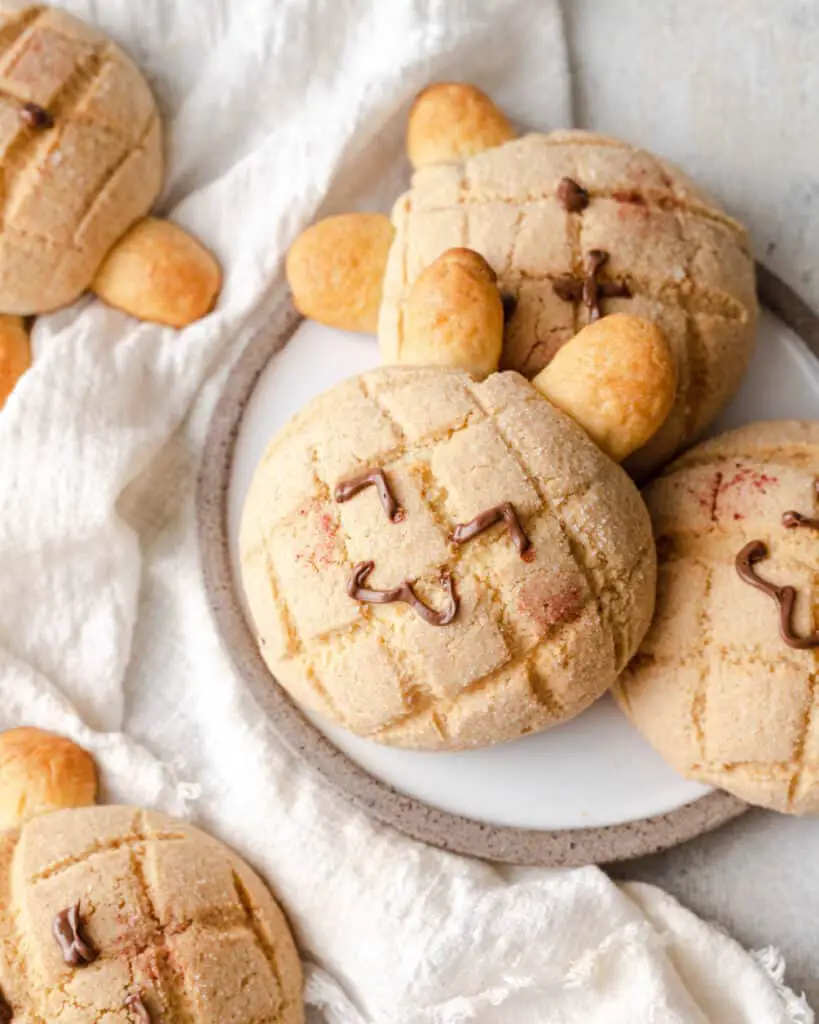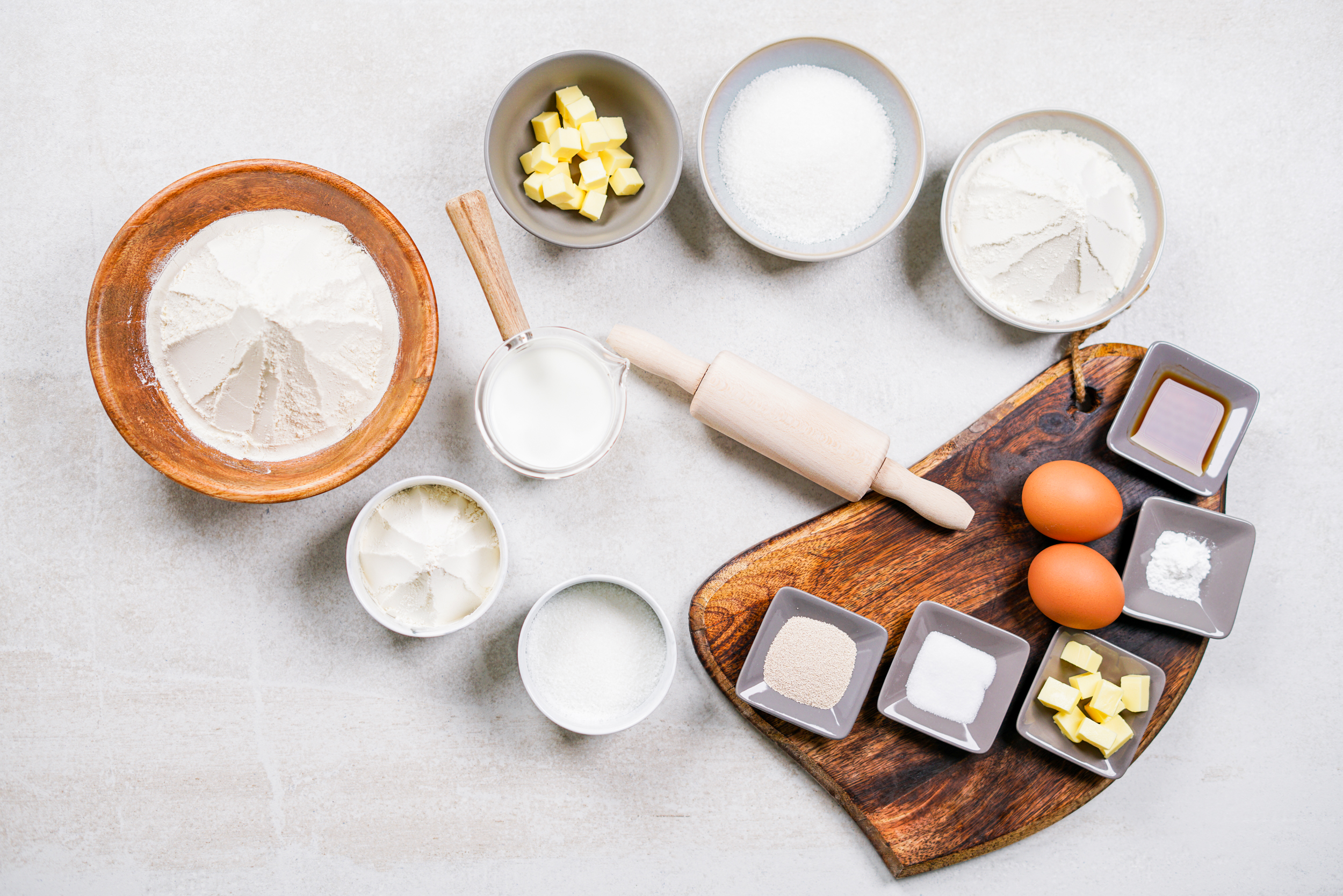
I love Japan's food, especially melon pan. It's a sweet bread with a cookie crust. It's soft and sweet, loved by many in Japan and worldwide.
It started in the Meiji period. Now, it's found in bakeries and homes everywhere. Its name might suggest fruit, but it's really about its texture and taste.
Melon pan is a treat you won't want to miss!
What is Melon Pan?
Melon pan is a Japanese pastry that many love. Its name might make you think of melon flavor, but it's actually about its shape. It looks like a melon. This pastry has a rich history, starting in the late 19th century when Japan began to adopt Western baking.
Origins and History
The story of melon pan is a mix of cultures. Western bakers brought their ways, and the Japanese made it their own. This mix created a sweet bread that people love. It was found in bakeries and enjoyed by many, becoming a part of Japanese culture.
Ingredients and Components
The ingredients of melon pan are what make it special. It's made with bread dough of flour, sugar, butter, and eggs. The top is a sweet cookie crust, also made from these ingredients. But, there's no melon flavor in the bread itself. It's the crunchy topping that stands out.
Understanding what goes into melon pan makes me appreciate it more. Each bite is a mix of textures and tastes that I enjoy.
Can’t visit a bakery? Try making it at home for a fresh and satisfying experience. For more ideas, check out this Amaro Montenegro recipe that pairs perfectly with desserts like melon pan.
The Unique Texture of Melon Pan
Melon pan is known for its contrasting textures, making it a joy to eat. The soft, fluffy interior is a result of careful proofing. This process lets yeast work its magic, creating a soft bread that feels almost ethereal.
-
Soft Bread Interior: The soft interior of melon pan is a perfect base for its flavors. Its gentle sweetness pairs well with the crunchy outside. When you bite into it, the warm, tender inside is a treat.
-
Crispy Cookie Crust: The outer layer of melon pan has a crispy cookie-like crust. This adds a delightful crunch to each bite. The contrast between the soft inside and the crunchy outside is a perfect harmony.
Classic Melon Pan Recipe
-
Prep Time: 20 minutes
-
Cooking Time: 15 minutes
-
Total Time: 2 hours (including proofing)
-
Yield: 8 servings
-
Method: Baking
-
Cuisine: Japanese
Ingredients and Components

Making melon pan requires two main components:
-
Bread Dough
-
2 cups all-purpose flour
-
2 tbsp sugar
-
1 tsp salt
-
1 tsp instant yeast
-
⅓ cup warm milk
-
1 large egg
-
2 tbsp unsalted butter (softened)
-
-
Cookie Dough Crust:
-
⅓ cup unsalted butter (softened)
-
½ cup granulated sugar
-
1 large egg
-
1¼ cups all-purpose flour
-
1 tsp baking powder
-
A pinch of salt
-
Granulated sugar (for sprinkling)
-
Instruction
-
Prepare the Bread Dough: Mix flour, sugar, salt, and yeast. Gradually add warm milk and beaten egg, kneading until a smooth dough forms. Add butter and knead for 10 minutes until elastic. Cover and let rise for 1 hour or until doubled.
-
Make the Cookie Crust: Cream butter and sugar, then mix in the egg. Sift in flour, baking powder, and salt, stirring until a soft dough forms. Divide into 8 portions and chill for 30 minutes.
-
Assemble the Melon Pan: Divide bread dough into 8 balls. Flatten cookie dough discs over each ball, covering them fully. Roll in sugar and score a crisscross pattern.
-
Bake: Preheat oven to 350°F (175°C). Place on a parchment-lined baking sheet, proof for 30 minutes, and bake for 12-15 minutes until golden.
Nutrition Facts (Per Serving)
-
Calories: 280
-
Sugar: 15g
-
Sodium: 180mg
-
Fat: 8g
-
Saturated Fat: 4g
-
Unsaturated Fat: 3g
-
Trans Fat: 0g
-
Carbohydrates: 42g
-
Fiber: 1g
-
Protein: 6g
-
Cholesterol: 35mg
Notes
-
For an extra crunchy crust, chill the cookie dough for at least 1 hour before assembling.
-
Experiment with flavors by adding cocoa powder or matcha to the cookie dough.
-
Store leftovers in an airtight container for up to 2 days. Reheat slightly for the best texture.
How to Eat Melon Pan

Eating melon pan is a joy, and I do it in ways that match my mood. Many wonder how to eat it, especially if they should use utensils. I like to eat it with my hands because the soft bread is easy to break and enjoy.
In casual settings, eating melon pan with fingers is my go-to choice. It's a simple and satisfying way to enjoy this treat.
-
Is Melon Pan Eaten with Fingers?: For me, eating melon pan with fingers is the best way. It lets me feel the soft inside and crispy outside in every bite. This way, I can fully enjoy the texture and taste.
-
Melon Pan Eaten with Fork or Chopsticks?: If I want to be neater, using a fork or chopsticks is a good option. It's handy when sharing with friends or in a more formal setting. But, the taste stays the same, no matter the tool.
-
Best Pairings for Melon Pan: I love trying different pairings with melon pan. My favorite is with sweetened iced green tea. It balances the sweetness of the melon pan perfectly.
Enjoying it with coffee or herbal tea also brings out the best in it. Each bite becomes a special treat.
Where to Find Authentic Melon Pan
Looking for authentic melon pan in the U.S.? You're in luck! Japanese bakeries across the country offer a wide variety of this sweet bread. Favorites like 85°C Bakery Cafe and Shirokuma Bakery are known for their delicious flavors.
I've explored many Japanese bakeries to find the best melon pan. Each place has its own special take on this classic treat. Some top spots include:
-
85°C Bakery Cafe – Known for its fresh and delicious pastries.
-
Shirokuma Bakery – Offers a cozy atmosphere along with scrumptious melon pan.
-
Tokyo Central – A marketplace with a bakery section that often features melon pan.
Can't get to a bakery? Making melon pan at home is a fun experience. It involves making two doughs: one for the bread and another for the cookie crust. Combining them before baking lets me enjoy fresh melon pan anytime.
There are many recipes for melon pan, suitable for all skill levels. This way, I can enjoy this beloved Japanese treat whenever I want.

Enjoying melon pan is more than just eating a sweet treat. It's a journey through its history, texture, and flavors. This Japanese delight combines soft bread with a crispy cookie crust. It's a pleasure that stays with you long after you finish eating.
Whether I find it at a bakery or make it myself, the experience is always rewarding. Each bite shows me the essence of Japanese food. I love trying both classic and new flavors.
I encourage you to try melon pan. Enjoy it in all its forms and savor every bite. It's a treat that should be part of your culinary adventures. I'm sure it will become a favorite of yours too.
And if you’re looking for more culinary inspiration, visit Tales Of A Kitchen for additional recipes.
FAQs
Q: How do I eat melon pan?
A: I usually tear melon pan apart with my hands. It's soft and breaks easily, so you don't need utensils.
Q: Is melon pan eaten with fingers?
A: Yes, it's common to eat melon pan with your fingers. The soft bread makes it easy to enjoy without making a mess.
Q: Can I eat melon pan with a fork or chopsticks?
A: While eating it with your hands is common, using a fork or chopsticks is okay too. It's a neater way to enjoy it.
Q: What are the different flavors of melon pan?
A: Melon pan comes in many flavors! The classic has a subtle melon taste. But, bakeries also offer chocolate, matcha, and sweet red bean flavors. They even have seasonal specials.
Q: What are the best pairings for melon pan?
A: I enjoy melon pan with tea or coffee. A sweetened iced green tea pairs well with it. It makes the experience even better!
Q: Where can I find authentic melon pan?
A: In the U.S., you can find authentic melon pan at Japanese bakeries like 85°C Bakery Cafe and Shirokuma Bakery. Or, you can try making it at home with recipes online!
Print
Melon Pan: A Taste of Japan's Sweet Bread Delight
- Prep Time: 20 minutes
- Cook Time: 15 minutes
- Total Time: 2 hours (including proofing)
- Yield: 8 servings 1x
- Category: Desserts
- Method: Baking
- Cuisine: Japanese
Description
Discover the allure of Japan's melon pan, an irresistible treat combining soft bread with a crisp cookie crust. Indulge in unique delicacy with Tales Of A Kitchen.
Ingredients
- Bread Dough
- 2 cups all-purpose flour
- 2 tbsp sugar
- 1 tsp salt
- 1 tsp instant yeast
- ⅓ cup warm milk
- 1 large egg
- 2 tbsp unsalted butter (softened)
- Cookie Dough Crust:
- ⅓ cup unsalted butter (softened)
- ½ cup granulated sugar
- 1 large egg
- 1¼ cups all-purpose flour
- 1 tsp baking powder
- A pinch of salt
- Granulated sugar (for sprinkling)
Instructions
- Prepare the Bread Dough: Mix flour, sugar, salt, and yeast. Gradually add warm milk and beaten egg, kneading until a smooth dough forms. Add butter and knead for 10 minutes until elastic. Cover and let rise for 1 hour or until doubled.
- Make the Cookie Crust: Cream butter and sugar, then mix in the egg. Sift in flour, baking powder, and salt, stirring until a soft dough forms. Divide into 8 portions and chill for 30 minutes.
- Assemble the Melon Pan: Divide bread dough into 8 balls. Flatten cookie dough discs over each ball, covering them fully. Roll in sugar and score a crisscross pattern.
- Bake: Preheat oven to 350°F (175°C). Place on a parchment-lined baking sheet, proof for 30 minutes, and bake for 12-15 minutes until golden.
Notes
- For an extra crunchy crust, chill the cookie dough for at least 1 hour before assembling.
- Experiment with flavors by adding cocoa powder or matcha to the cookie dough.
- Store leftovers in an airtight container for up to 2 days. Reheat slightly for the best texture.
Nutrition
- Serving Size: 1
- Calories: 280
- Sugar: 15g
- Sodium: 180mg
- Fat: 8g
- Saturated Fat: 4g
- Unsaturated Fat: 3g
- Trans Fat: 0g
- Carbohydrates: 42g
- Fiber: 1g
- Protein: 6g
- Cholesterol: 35mg


